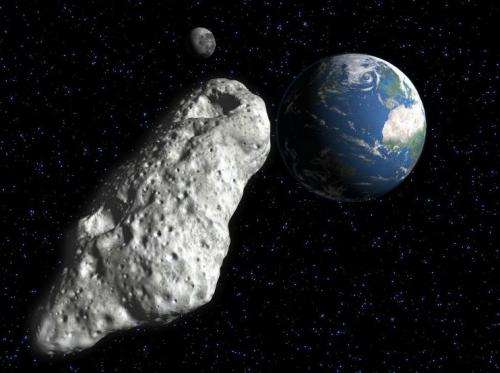Asteroids no match for paint gun, says professor

(Phys.org)—There is research that is off the wall, some off the charts and some off the planet, such as what a Texas A&M University aerospace and physics professor is exploring. It's a plan to deflect a killer asteroid by using paint, and the science behind it is absolutely rock solid, so to speak, so much so that NASA is getting involved and wants to know much more.
Dave Hyland, professor of physics and astronomy and also a faculty member in the aerospace engineering department at Texas A&M and a researcher with more than 30 years of awards and notable grants, says one possible way to avert an asteroid collision with Earth is by using a process called "tribocharging powder dispensing" – as in high pressured – and spreading a thin layer of paint on an approaching asteroid, such as the one named DA14 that came within 17,000 miles on Feb. 15.
What happens is that the paint changes the amount by which the asteroid reflects sunlight, Hyland theorizes, producing a change in what is called the Yarkovski effect (which was discovered by a Russian engineer in 1902). The force arises because on a spinning asteroid, the dusk side is warmer than the dawn side and emits more thermal photons, each photon carrying a small momentum. The unequal heating of the asteroid results in a net force strong enough to cause the asteroid to shift from its current orbit, Hyland further theorizes.
The kind of paint used is not the kind found at your local hardware store, Hyland explains.
"It could not be a water-based or oil-based paint because it would probably explode within seconds of it entering space," he notes.
"But a powdered form of paint could be used to dust on the asteroid and the sun would then do the rest. It cures the paint to give a smooth coating, and would change the unequal heating of the asteroid so that it would be forced off its current path and placed on either a higher or lower orbit, thus missing Earth.
"I have to admit the concept does sound strange, but the odds are very high that such a plan would be successful and would be relatively inexpensive. The science behind the theory is sound. We need to test it in space."
As for getting the paint on the asteroid, a practical way to do this was discovered by a former student of Hyland's, Shen Ge, who has since started a new space company. The "tribocharging powder dispenser" would spray a mixture of inert gas and charged dry-paint powder at the asteroid that would attract the powder to its surface through electrostatics. Then solar wind and UV radiation would cure the powder, giving a smooth, thin coat on the surface.
Getting the paint in the asteroid's path in a timely manner will certainly be a challenge, Hyland observes.
"The tribocharged powder process is a widely used method of painting many products," he says. "It remains only to adapt the technology to space conditions."
NASA has approached Hyland for developing such a project to test the theory, and the Earth may need it quickly. An asteroid called Apophis is due in 2029 and will come closer than many communications satellites in orbit right now. It will fly by on April 13 (Friday the 13 to be exact) of 2029 and make a return trip in 2036, and it's estimated to be more than 1,000 feet in length and is appropriately named for an evil Egyptian god of chaos and destruction. There is no chance of its hitting Earth in 2029, but a small chance in the next close approach in 2036, Hyland notes.
Asteroids have hit Earth before. One hit off the Yucatan coast of Mexico about 65 million years ago and is believed to have caused the eventual extinction of the dinosaurs. And in 1908, the fabled "Tunguska event" occurred in Siberia in which an asteroid or meteor exploded several miles above the Earth, flattening trees and killing livestock over 800 square miles. The explosion is now estimated to have been 1,000 times more powerful than the A-bomb dropped on Hiroshima.
"There are thousands of asteroids out there, and only a small percentage of them are known and can be tracked as they approach Earth," Hyland adds.
"The smaller ones, like DA14 are not discovered as soon as others, and they could still cause a lot of damage should they hit Earth. It is really important for our long-term survival that we concentrate much more effort discovering and tracking them, and developing as many useful technologies as possible for deflecting them."
Provided by Texas A&M University



















